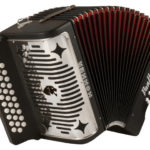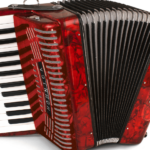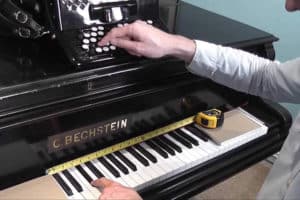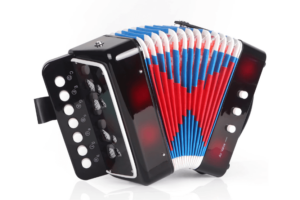A small piano accordion vs button accordion rivalry has always existed. While there are many similarities, a closer inspection will reveal many differences. In this article, I’ll describe the key differences of the piano accordion vs button accordion, including the pros and cons of each.
Piano accordion vs button accordion – what are the main differences? The piano accordion has piano keys on the right-hand (treble) side. The button accordion has buttons on the right-hand side. The piano accordion can be easier to learn; however, the button accordion can be easier to play as the buttons are closer together.
Read on to know more about the similarities and differences of the piano accordion vs button accordion, including the pros and cons of each.
Also, we hope you find the links here useful. We may get a commission if you purchase something through a link on this page, so thank you!
Piano Accordion Vs Button Accordion
Accordions come in a variety of shapes, sizes, colors, and aesthetic designs. The two main categories of accordions include the piano accordion and the button accordion.
Some things that would set these two apart are aspects like the year the accordion was made, the number of keys, reeds, and even the actual material used to produce the instrument. Later, we will look at the brief history and features of each instrument.
In the meantime, here is a quick and easy guide to help you better distinguish the two from each other, aside from their appearance.
| Piano Accordion | Button Accordion | |
| General Aspect or Identifying Characteristic | Has piano keys on the right-hand (treble) side | Has buttons on the right-hand (treble) side |
| Range | Maximum of 45 notes | Maximum of 64 notes |
| Bass Systems | Stradella, French 3-3, or Free Bass | Stradella, Free Bass, or Converter Bass |
| Size | Based on # of basses: 12, 48, 72, 96, or 120. The more basses, the bigger (and heavier) the instrument. | Smaller and more compact regardless of its bass range |
| Octaves | Up to 3+ octaves | Approximately 4+ octaves |
| Ergonomics | Relaxed finger & wrist position, but better reach is required | Requires twisting of fingers & wrist, but with better reach due to the spacing of the buttons |
| Sound | Best known for American folk, polka, classical & jazz music | Best known for ethnic dances, Russian folk, Balkan music, and Cajun Music |
| Popularity | Brazil, Chile, Scotland, South Africa, USA, Uruguay, New Zealand, Australia, Scandinavia, France, & Belgium | Argentina, Austria, The Bahamas, Canada, Dominican Republic, Eastern Europe, England, France, Ireland, & Northern Mexico |
Here are some more details about the major differences between a button accordion vs piano accordion:
1. Simplicity
The piano accordion is more straightforward than the button accordion as far as its construction is concerned. In a piano accordion, each key represents one particular note: in every half-step, the artist has to move down or go up by one step.
In contrast, a button accordion has a uniform arrangement. The musician must play the buttons associated with the particular note to be played.
2. Number of Notes
A piano accordion cannot have more than 45 notes, while a button accordion’s right-hand register can have a maximum of 64 notes.
3. Fingering Pattern
Two different chords can be played with the same fingering pattern when using a button accordion. On the other hand, playing a chord on a piano accordion requires the same form and technique employed by a pianist.
4. Key Design
All the keys in a piano accordion are functional and can be played by an artist. But in a button accordion, there are dummy buttons that are only affixed for aesthetic purposes.
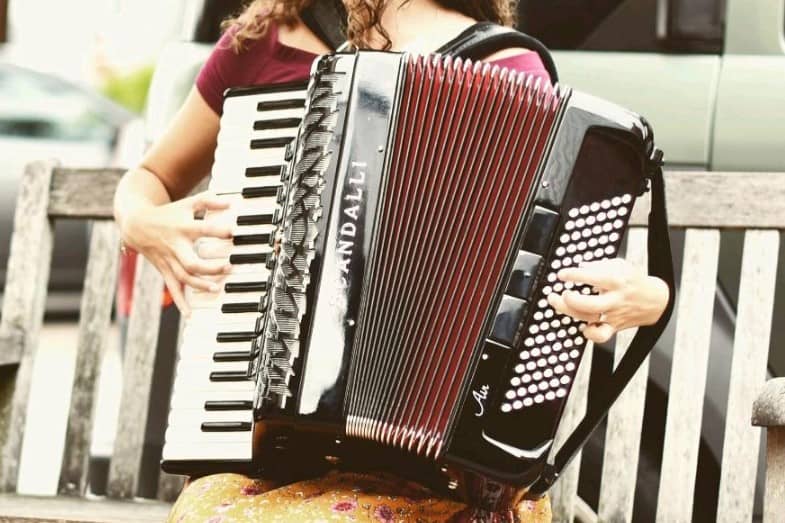
5. Ease of Playing
The button formation allows an artist to play notes easily, even when the notes are far apart. Also, its construction reduces the risk of playing the wrong notes.
In a piano accordion, the musician is required to be very precise since playing far apart notes can be very tricky due to lack of reach.
6. Transposition
The duplicate rows on a button accordion allow easier transposition between notes, unlike in a piano accordion that requires an exact fingering pattern. This problem usually becomes apparent when you’re accompanying a singer who is unable to sing at a particular range.
7. Average Size
A piano accordion is generally larger with a more protruding right-hand side than a button accordion. This size accommodates the internal structure required for a piano accordion. But for the button accordion, a smaller frame does not affect its range in any way.
8. Comfort
It is more comfortable to play a piano accordion due to its wider surface area. The compressed area of a button accordion would sometimes require an artist to twist his wrist and fingers so he can press the buttons.
You can clearly see the musical talents employed in both accordion types in this video.
What Is a Piano Accordion and What Are Its Features?
A piano accordion is the most popular out of all types of accordions. But it was not always as popular as it is today.
Click here to see this piano accordion on Amazon.
Below is a short history of this beautiful piece of instrument.
The 1850s to 1870s
Historical archives detail the first piano-like accordion in 1852 by Bouton of Paris, but other sources claim that the instrument was introduced in Munich in 1854 by instrument builder Matthäus Bauer. And in 1871, Russian harmonist Nikolay Ivanovich Beloborodov built the first chromatic piano-like accordions.
The 1900s
Its popularity greatly increased in the 1900s, especially in the United States. The term “piano accordion” was coined by Count Guido Pietro Deiro, a well-renowned vaudeville star and virtuoso, in 1910.
He was the first-ever piano accordionist to appear in big-budget vaudevilles, on the radio, records, and even on screen. Together with his brother Pietro Deiro, both had significant contributions in the introduction of the piano accordion in the early 20th century and to its eventual popularity.
The 1970s
By 1972, the piano accordion has dominated the English-speaking North American continent, certain East European countries, and even Scotland. To this day, the piano accordion is still the predominant accordion type in countries like Italy, Australia, New Zealand, and South Africa. Fun fact: it is the official city instrument of San Francisco, California.
Features
The piano accordion can create some of the simplest to the most complex tunes thanks to its features. It ranges from 25 to 45 piano keys on the right-hand side to provide the treble and a bass chord keyboard on the left-hand side. However, its acoustic mechanism is more similar to an organ than a piano, as both are wind instruments.
Its most popular system is called “Stradella” or the bass-chord system, which typically has one hundred and twenty (120) bass buttons. It employs the power of the piano but is a much portable version. The size of a piano accordion also depends on the proportion of piano keys to the number of bass buttons.
Click here to see this Professional Accordion for Kids on Amazon.
What Is a Button Accordion and What Are Its Features?
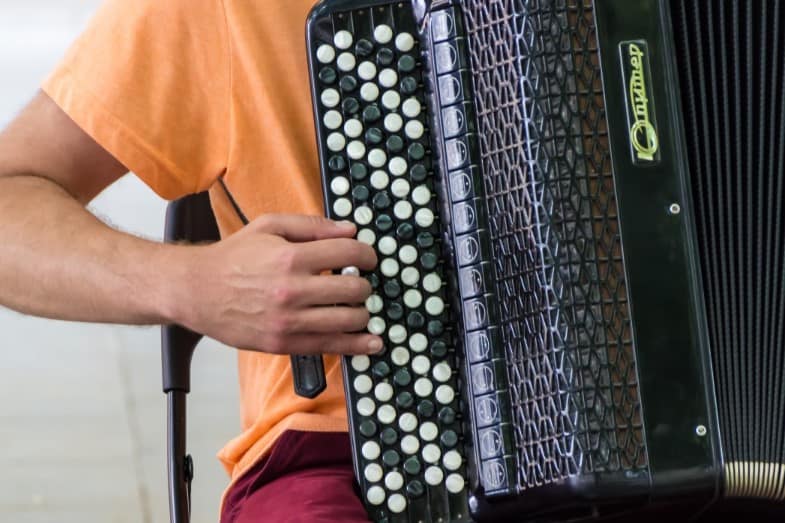
As the name suggests, a button accordion has a series of buttons on the instrument’s melody-side keyboard rather than the piano-style keys in a piano accordion. Button accordions are especially popular in European countries and anywhere people of European descent have settled.
Not much is recorded regarding the history of the button accordion, except that Franz Walther, a Viennese musician, built the first button accordion.
The two types of button accordions are chromatic and diatonic. Each type has distinct features.
1. Diatonic Button Accordion
As the name suggests, this type showcases 2 or 3 rows of buttons, with each row tuned into a specific key. This type of accordion is widely used in Irish, Cajun, and British ethnic music.
Most diatonic button accordions are also bisonoric, which means one button can produce two different notes while pushing or pulling the bellows.
2. Chromatic Button Accordion
This type of button accordion is unisonic, which means each button produces one note, regardless of whether the bellows are being pushed or pulled. It also has 3 to 5 rows of buttons like the diatonic button accordion. However, it can be played freely with identical fingering patterns, which the diatonic would not be capable of.
Chromatic button accordions are also used in some ethnic dances, but they are more suitable for classical and jazz music than the diatonic.
Click here to see this Hohner Compadre G/C/F 3-Row Diatonic Accordion on Amazon.
Piano Accordion or Button Accordion: Which One Should You Pick?
We already know that piano accordion is more popular, so is there even a point in considering the button accordion? To help decide which one’s for you, here are some advantages and disadvantages of a button accordion:
Advantages
- The button accordion is more compact, regardless of range. Thus, it’s more portable and easier to carry around.
- It has a larger note span from thumb to pinky finger (2 octaves against 1 octave for piano accordion).
- Since it is smaller, more compact, and more lightweight, it is common for women and children to pick button accordion over piano accordion.
- It has uniform fingering patterns in any position, making it easier to learn. Also, it has less margin for error in playing.
- Button accordions in the market have more fun designs and look less serious, which might be a plus for those with more artistic personalities.
Disadvantages
- Since it is not as popular as the piano accordion, reselling a button accordion will be harder to do.
- The button accordion is also harder to find and less available in the second-hand market.
- There are fewer teachers available, as there are more teachers or players for the piano accordion (even YouTube tutorials are pretty scarce). Thus, it would be a bit more costly to hire a music teacher who specializes in playing the button accordion.
- Although not impossible, learning or shifting from piano to button accordion would take time, around 6-9 months, to be more specific.
Click here to see this Eastar Kids Accordion Toy Accordion on Amazon.
Conclusion – Button Accordion Vs Piano Accordion
The accordion is one of the more underrated musical instruments. It has stayed in the music scene even after the “Golden Age of the Accordion” (the 1990s-1960s).
It might not have been widely talked about, but Bruce Springsteen has several tracks that make use of the accordion. Proud accordion-centric acts like The Lumineers and Arcade Fire have won Grammys, and two accordionists, Krist Novoselic (Nirvana) and Nils Lofgren (E Street Band), have been inducted into the Rock and Roll Hall of Fame.
Hardcore accordion fans and members of the music community point out a rise in interest in playing the accordion in the past few years. And we all have the “retromania” or seeming obsession for things that say “throwback” to the past to thank.
So, to recap, which one wins in the battle of button accordion vs piano accordion – which is better? Which type of accordion should you play?
The button accordion has keys on the right-hand (treble) side. The piano accordion has piano keys on its right-hand side. The piano accordion can be easier to learn, especially if you already know how to play the piano. However, once the buttons are learned on a button accordion, a button accordion can be easier to play as the buttons are closer together.
In the end, it still boils down to preference. It depends on the kind of accordion best suited for an individual artist or player. A few factors, such as skill, comfort level, and the overall feel of the instrument also matter.
It takes eagerness and discipline to be able to master both the piano and button accordions, as both have qualities that are different from each other. That is why many enthusiasts would pick just one of the two rather than learn both.
Related reading:
Best Accordion – Top 10 Button and Piano Accordions
Harpsichord vs Piano – What Are the Differences?
Organ Vs Piano – What are the Differences?






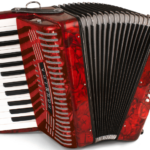

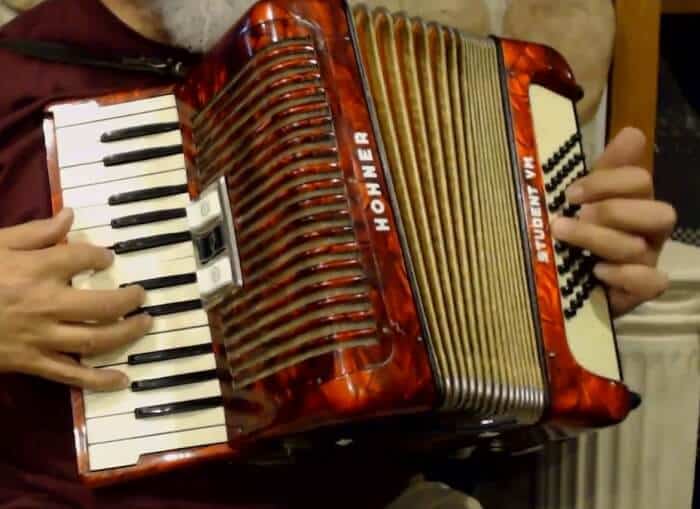
![Accordion-like Instruments [Full List] accordion like instruments](https://musicalinstrumentpro.com/wp-content/uploads/2022/09/accordion-like-instruments-150x150.jpg)
